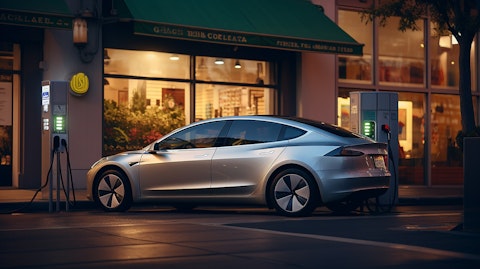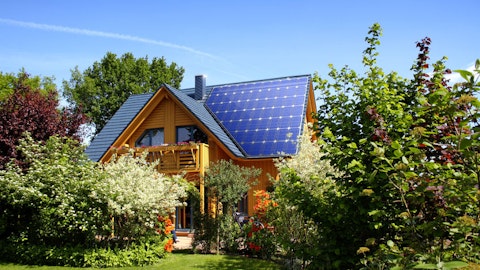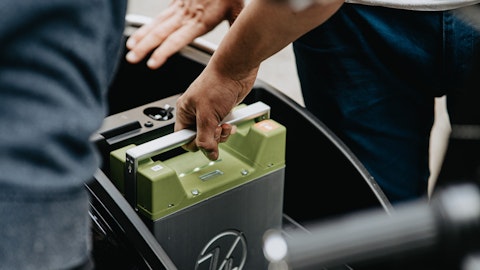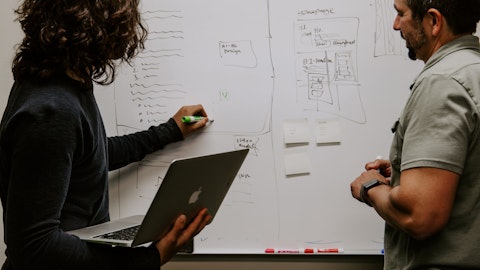Solid Power, Inc. (NASDAQ:SLDP) Q3 2023 Earnings Call Transcript November 7, 2023
Solid Power, Inc. beats earnings expectations. Reported EPS is $-0.08, expectations were $-0.11.
Operator: Greetings. Welcome to Solid Power, Inc. Third Quarter 2023 Financial Results and Business Update Call. Please note that this event is being recorded. I’ll now turn the conference over to your host, Jennifer Almquist, Investor Relations for Solid Power, Inc. Thank you. You may begin.
Jennifer Almquist: Thank you, operator, and thank you, everyone, for joining us today. I’m joined on the call today by Solid Power’s President and Chief Executive Officer, John Van Scoter; and Chief Financial Officer, Kevin Paprzycki. A copy of today’s earnings release is available on the Investor Relations section of Solid Power’s website at ir.solidpowerbattery.com. I’d like to remind you that parts of our discussion today will include forward-looking statements as defined by U.S. Securities Laws. These forward-looking statements are based on management’s current expectations and assumptions about future events and are based on currently available information as to the outcome and timing of future events. Except as otherwise required by applicable law, Solid Power disclaims any duty to update any forward-looking statements to reflect future events or circumstances.
For a discussion of the risks and uncertainties that could cause actual results to differ materially from those expressed on today’s forward-looking statements, please see Solid Power’s most recent filings with the Securities and Exchange Commission, which can be found on the company’s website at ir.solidpowerbattery.com. With that, let me turn it over to John Van Scoter.
John Van Scoter: Thank you, Jen, and good afternoon, everyone. Thank you for joining the call today. I’ll begin today with an important milestone, our A Sample EV cell shipments and entrance into automotive qualification. I’ll then provide an update on our solid overall progress and give early thoughts on 2024 priorities and goals. After that, I’ll hand the call off to Kevin for the financial review and we’ll open up Q&A. Over the last week or so, we shipped more than 80 of our EV cells to BMW to officially begin the automotive qualification process. This is no small achievement. A year ago, we were struggling with yield issues on our 20-amp hour cells as we initially scaled up our roll-to-roll line production. Since then, the team has overcome those obstacles and more, including a few significant supply chain and vendor quality issues on both the cell and powder production side.
We’ve done this while completing SP2 construction, initiating powder production and incorporating our new SP2 powder into cells. I want to extend my gratitude to the team and reiterate my appreciation for the strong team I’ve inherited. Looking more closely at the EV cells we just shipped. These EV cells meet BMW’s initial performance expectations and represent our first or A-1 cell for the automotive qualification process. These A-1 cells are 60-amp hour have 40 layers and are about 10 by 30 centimeters in size. Importantly, they were also produced on our EV cell line using electrolyte from SP2. We expect A-1 cells are to be followed by A-2 and A-3 cells each with increased performance targets that we will collaborate with BMW to meet their expectations.
We still have a way to go to hit the increased performance targets for A-2 and A-3, but this is a great start, and we are now on a path to work with our partners to hit those targets. We can’t provide details at this point, but if we continue to improve towards those A-2 and A-3 targets, we believe we will drive greater range, battery life and safety for the consumer, while driving down cost for the OEMs. These cells are not only a key step towards the commercialization of Solid Power’s technology, they are a key step for BMW’s demo card program as well. The cells are slated for module and pack builds this year and together, we are targeting them to power a full-size BMW EV in 2024. Our ability to enter A Sample was bolstered by the investments we’ve made in quality assurance equipment and processes.
These include the x-ray and CT scan equipment that we acquired and fully implemented into our processes earlier this year. It also includes some new innovative screening techniques that the team developed, which enable us to identify and address problems more efficiently. Collectively, these processes helped us get into automotive qualification and also give us confidence the cells we have delivered will meet the targets laid out for us. Uniformly across all shipments, which is critical for overall EV pack performance. It’s also worth mentioning that these cells came off our EV line at SP1 with solid power and BMW employees working side-by-side on their development. BMW’s efforts to accelerate the development of our solid-state technology was a huge driver and we are grateful for their collaboration.
Now that we’re successfully producing A-1 cells, we have also separated our two lines with each running concurrently. Our ED cell line is focused 100% on our A Sample cell production for our partners. And our pilot or development line now fully dedicated to advancing our self performance including R&D on our next-gen cells. During my travels this quarter, I got to visit BMW’s battery development facility in Parsdorf, Germany. The facility is impressive and the facilities and infrastructure are progressing with their line to be built over the coming year. A substantial square footage will be dedicated to continued development of Solid Power’s technologies and staffed by BMW’s experienced battery engineers. Once complete, this line will expand development activities of our solid-state technologies in two regions of the world.
In addition, we continue to progress the Ford and SK On cell requirements, which, in some respects, are different than BMWs. On the electrolyte side, since we began production of our electrolyte powder in SP2 in April, we have been diligently working to increase production volumes and efficiencies. The team has done a great job. We have the final configuration of our production line in place and are now producing powder at sufficient volumes and quality to use SP2 Powder in the manufacture of our EV cells. Importantly, we stopped producing powder at SP1 and begun to redeploy our SP1 team and resources towards development of our next-gen powders. We feel good about our capability to produce 1.25 metric tons per month at SP2 by the end of this year.
As we’ve said previously, demonstrating production at this scale is important as potential customers prefer to take product from large production runs. So far this year, we have provide SP2 electrolyte samples to two potential customers and are working towards providing samples to four more in the near future. We believe many EV OEMs and Tier 1 battery producers have a sulfide-based solid-state product in their future road map. The scale and high quality of the powder we are now putting out puts us in an incredible position to be the leader in supplying them the electrolyte they will need. Lastly, I’d like to take a moment to briefly update you on the strategic priorities I outlined last quarter as well as a couple more we’ve added to our list.

We’re still refining our 2024 goals, but I feel these priorities will likely form the basis for what we want to achieve next year. On last quarter’s earnings call, I outlined three initiatives that I saw as immediate strategic priorities, specifically establishing a presence in Korea, increasing our strategic supply chain capabilities, and elevating our external and investor communications. First, establishing a presence in Korea. During the quarter, we established a new legal subsidiary to do business there. Secured and opened office space in Korea and laid the groundwork for collaboration with the Korean national labs and universities. Most importantly, we visited Peninsa [ph] over an approximately 10-day period with some of my senior team.
During the trip, we’ve added options with our partners, suppliers and potential customers and got very positive feedback on our plans. We evaluated our options and narrowed down to a few potential paths to further expand our Korean presence. We feel good about our plan and our ability to make progress over the next few months. Our plan should allow us to accelerate building our team in Korea and tapping into the world-class battery talent pool that exists there. We look forward to sharing more when we can. Second, elevating our strategic supply chain activity. During the quarter, we battled through the similar grade material issues we have been facing. I think the team did a fantastic job ensuring we kept development and production moving forward while working with our suppliers to address root causes.
We also began the recruiting process for the key supply chain leadership we need and met with potential new suppliers in Korea for critical materials. Lastly, on supply chain, we successfully implemented SAP on October 1, and going live with supply chain and accounting functions. We are excited about the tools this will provide. Our team did a great job here keeping this project on time and under budget. And I’d like to thank the many involved for the tireless and successful efforts. Third, elevating our external and investor communications efforts. During Q3, we continued to meet with shareholders, but increase the amount of interactions significantly. We completed a positive series of meetings in a non-deal roadshow and are planning another in Q4.
A few weeks ago, we posted a new investor deck, which does a good job summarizing Solid Power’s investment thesis. Also from a media perspective, we increased our PR efforts with social and print media. We’ve done three to four interviews with a great Denver Post article published and the rest on the way. IR planning is well underway for 2024 with a focus on increasing higher quality interactions and greater visibility. We are planning an Investor Analyst Event sometime in 2024, where we expect to provide a comprehensive technical update on our cell and electrolyte progress, provide insight into our commercialization time line and update our high-level financial projections. Lastly, on IR, one of the things we hear consistently from investors is that they’d like to have more frequent updates.
To be clear, we will only release news when we have meaningful news to share. While our progress has been strong, we will not always have major news to share on a frequent or consistent schedule. When we hit significant milestones or accomplish one of our goals, we will proudly release it. But world-changing development progress isn’t always linear. Shifting gears toward new priorities. In October, the senior team at Solid Power spent a couple of highly productive days working off-site on longer-term strategic plans and initiatives. Following those meetings, we’ve added two additional priorities, which we’ll focus on in 2024. The first is seeking at least one additional OEM partner. A new OEM partner must be additive in terms of collaborative expertise and also fully aligned with our current partners’ objectives.
The second is accelerating our revenue time line to drive cash generation opportunities. We expect any new revenues to be driven by electrolyte sales. Feedback from our current sampling process continues to be positive. Each of these new objectives demonstrates our competitive urgency and the shift towards growth and technology commercialization. Collectively, all five of these priorities will likely form our goals for the year. As we fully plan out these new priorities and set our goals and guidance for 2024, we’ll go into them in more detail. With that, I’ll hand it over to Kevin to take you through our financial results. Kevin?
Kevin Paprzycki: Thanks, John. Good afternoon, everyone. I’ll start off with an overview of our financial results and then update our 2023 outlook. Overall, solid operational performance has us tracking favorable to our ops and CapEx targets for the year, strengthening our solid liquidity position. Our third quarter 2023 revenue of $6.4 million was in line with our expectations and again driven by strong execution on our development and government contracts. Third quarter 2023 operating expenses were $27.9 million, up $9.5 million from last year. This increase represents expanded efforts to build our EV sales and increase our electrolyte production. We expect these development-related investments to be slightly higher in the fourth quarter than they were in the first three quarters of 2023.
Our third quarter 2023 operating loss was $21.5 million, and net loss was $15.1 million. Touching on our balance sheet and liquidity; during the third quarter we invested $15.3 million in operations and $8.3 million in CapEx. We ended the quarter with total liquidity of $422.3 million consisting of cash, marketable securities and long-term investments. Looking ahead to the rest of 2023 right now, we believe both our operational and capital spend will be slightly favorable to the low-end of our guidance range for the year. We continue to expect revenue in the range of $15 million to $20 million but we believe our 2023 cash investments will come in slightly below the $70 million low-end for operating and the $50 million low-end for CapEx. I want to praise the ops teams here as these favorable reductions are driven by positive factors.
On the operating side, our EV cell development and yields have been solid, meaning we have needed to build fewer cells. This translates into less material and labor spend. On the CapEx side, the team has done a great job optimizing processes and finding more cost-effective ways to structure our SP2 powder line. As a result, we have been able to eliminate some of our planned equipment. There are also some investments where we can prudently wait until 2024 to make. Those will get picked up when we give guidance for next year. So taking into account those favorable investment spends, we now expect ending liquidity for 2023 slightly above the high end of our guidance range, which was $375 million. Finishing up, at this point, we have no real change or update to our longer-term projections.
Although this great spend performance by our ops team helped strengthen our overall liquidity. With our capital-light business model, we are still sitting in a very solid position for the long-term with the ability to run all the way to the late-20s with our current cash and longer as we secure the financing or grant funding that we’re pursuing. We plan to give financial guidance for 2024 at year-end with longer-term high-level projections provided during our planned 2024 IR event. With that, I’ll now turn the call back to John.
John Van Scoter: Thanks, Kevin. Before we head to Q&A, I’d like to reiterate that since I’ve stepped into this role almost five months ago I’ve been incredibly pleased with the Solid Power team I’ve inherited. One of Solid Power’s core values is to earn credibility through execution. I believe the team here does that on a daily basis at all levels. In just a few months, I’ve seen excellent execution in driving a sample cell deliveries and ramping high-quality SP2 electrolyte production despite battling through technical and supply chain challenges. Solid Power continues to execute on its technical, customer and financial targets. We are confident continuing to execute this way will drive long-term shareholder value. With that, I’ll hand it over for Q&A.
See also 25 Most Powerful Countries in Europe and 10 DumBest Companies to Invest In.
Q&A Session
Follow Solid Power Inc.
Follow Solid Power Inc.
Operator: Yes. Thank you. [Operator Instructions] And the first question comes from Mike Shlisky from D.A. Davidson.
Mike Shlisky: Good afternoon and thanks for taking my questions. So John, I think be in Korea sounds great. Glad you are making some headway there opening in office and getting things started. And you already do have a presence kind of in Europe given where you’re working with BMW. I was wondering if or kind of why don’t you have other plans for perhaps Japan or China or elsewhere for additional opportunities? Or is it going to be kind of one-step at a time here.
John Van Scoter: Yes. I think it is one-step at a time. But my vision for the Korean office is actually to operate throughout Asia. That’s one of the beauties of planting the flag there initially. I think we can do work in Japan and the rest of Asia from that location. But yes, I do think we’re going to stepwise and just be mindful of the costs associated with creating satellite offices, but balance that against the opportunity to support our partners and develop supply chain relationships and procure world-class talent.
Mike Shlisky: Great. Thanks for that color. I wanted to turn to the strike that’s underway or just wrapping up here in the U.S. at the big three automakers. There’s some headlines to what’s in the new contracts that come out. We don’t have an individual company they all kind of seem somewhat similar. I guess if you – are you – have you gotten any feedback from any of your partners that there will be changes to the time line or amount of investments in the EV vehicles or in the battery facilities at this point?
John Van Scoter: Yes. We’ve been monitoring this very regularly since all the headlines have come out from the various strikes and so forth, and plant pausing and the like. But honestly, we have not seen any change in terms of the pull from our partners from around the globe. All of the push that they’ve had for specific time lines and requests really haven’t changed. So we’re very pleased with that. It may just be the time horizon that they’re looking at for the commercialization that’s driving that. But we’re still under a lot of pressure to perform – to be in a position to have commercialized technology by 2028.
Mike Shlisky: Great. I appreciate those comments. I’ll pass it along. Thank you.
Operator: Thank you. And the next question comes from Vincent Anderson with Stifel.
Vincent Anderson: Yes. Thanks. So Toyota hasn’t necessarily been quiet about its sulfide technology, but I am curious if you noticed any shift recently in the conversations throughout the industry after their announcement of working on raw material integration with Idemitsu. I would imagine it’s a net positive to have the chemistry further validated by these big market participants. But I’m wondering if it’s translated yet into an uptick in interest or urgency from any of your potential electrolyte customers that see that as a competitor?
John Van Scoter: Yes. We do see it as a net positive with major players now backing sulfide-based All-Solid-State Batteries in their road map. We think that there’s room for multiple winners. And we think that given our position from ability to produce volume electrolyte now and our plans to grow that in the future that we’re very well positioned to participate with the players that are intending to be there with sulfide-based ASSPs.
Vincent Anderson: Perfect. Thanks. And then could you just refresh my memory on if there’s any tie between SP1 and SP2, with regard to some of the optimization you’re doing around your electrolyte chemistry insofar does SP2 accelerates that or optimizing the chemistry further was part of the step of moving to SP2 at scale or are those completely independent?




